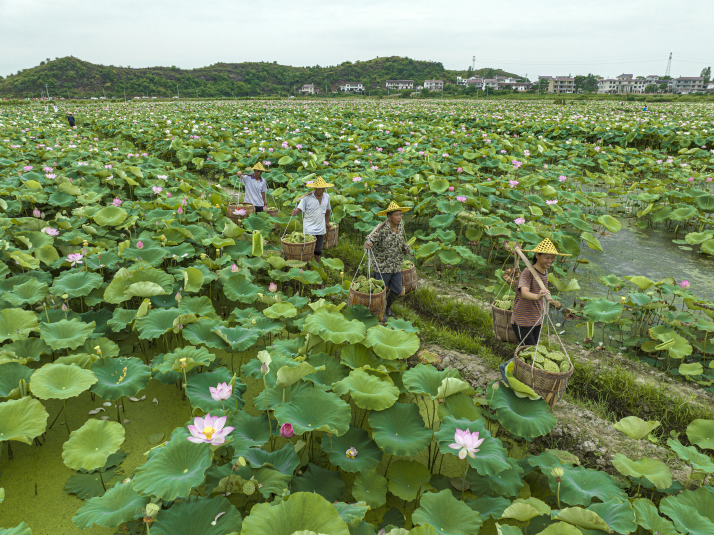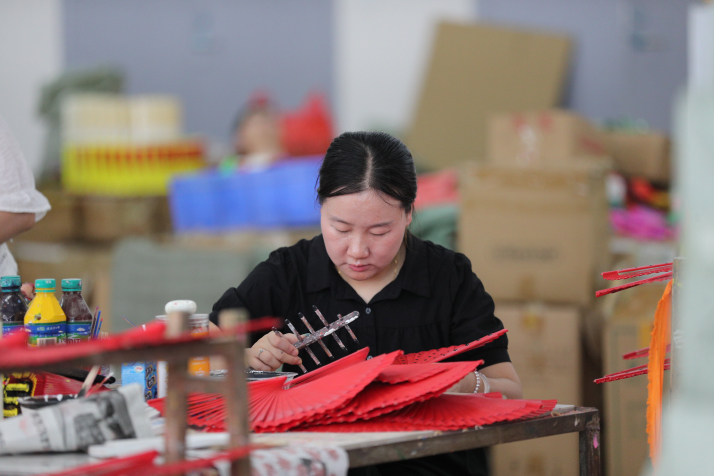| China |
| A "beautiful economy" leads Guangchang County to rural revitalization | |
|
|
|
Waist-deep in the Red Lotus Fields of Zhangshu Village, farmers waded among the blossoms on the morning of July 30, harvesting ripe lotus pods and dropping them into bags. Located in Ganzhu Town in Guangchang County, Jiangxi Province, the fields seemingly stretch endlessly toward the horizon, merging with the summer sky. The pink flowers and broad green leaves swayed gently as villagers hauled bulging sacks of lotus pods ashore. Their harvest would soon be processed and sold nationwide—either through local brokers or via e-commerce platforms—adding a taste of summer to dinner tables across China.
The key to this abundance lies in Guangchang's unique "space lotus"—lotus varieties bred from seeds sent into orbit, which grow faster and offer higher quality than conventional strains. Thanks to this innovation, Guangchang's lotus cultivation now covers about 7,333 hectares, generating an annual output value of around 860 million yuan ($120 million). Just a few years ago, this county was poverty stricken. By July 2018, it had officially lifted itself out of poverty and embarked on a fast track toward rural revitalization.  Lotus farmers harvest and carry freshly picked lotus pods in the Red Lotus Fields of Zhangshu Village in Ganzhu Town, Guangchang County, Jiangxi Province, on July 30 (Zeng Henggui)
Guangchang's transformation from poverty to prosperity is one of many similar stories playing out across China's vast countryside. In 2024, China's grain output hit a record high of 706.5 million tons; per-capita disposable income of rural residents rose to 23,119 yuan ($3,246), up 6.6 percent year on year; and over 33 million formerly impoverished people found jobs. By the first quarter of 2025, rural areas nationwide had welcomed 707 million tourists, up 8.9 percent from the previous year, generating 412 billion yuan ($57 billion) in revenue—a 5.6-percent increase. This momentum is rooted in a national policy blueprint. In March 2021, the Outline of the 14th Five-Year Plan (2021-25) for National Economic and Social Development and Vision 2035 of the People's Republic of China was released, prioritizing agricultural and rural development. The outline sets out a comprehensive action plan to enhance agricultural quality and competitiveness, implement rural development initiatives, promote integrated urban-rural development, and link the consolidation of poverty alleviation achievements with rural revitalization efforts. Against this backdrop, Guangchang has charted its own path: developing strong agriculture, fostering a beautiful countryside, and ensuring its population is well-off through innovation and adapting new ideas and technologies to local conditions. The rise of lotus Lotus ponds can be found everywhere in Guangchang. As China's hometown of the white lotus, Guangchang has a lotus cultivation history of more than 1,300 years, with the flower deeply rooted in the land and its people. The lotus is not only beautiful, but also holds deep cultural meaning in China, symbolizing purity and nobility. It is also entirely practical: Every part of the plant has value. The seeds, roots and leaves can be used in traditional medicine or transformed into culinary delicacies. The people of Guangchang have given this ancient flower a new mission: to drive rural revitalization. In line with the 14th Five-Year Plan's call to enhance agricultural efficiency and competitiveness, Guangchang has harnessed science and technology to breathe new life into its lotus industry. At the Guangchang Lotus Science and Technology Expo Park, more than 500 varieties bloom. The spectacle is the result of decades of agricultural innovation: Since the 1990s, Guangchang has sent white lotus seeds into space six times, resulting in the "space lotus" varieties. Conditions in space accelerate the natural process of genetic mutation within plant varieties, offering scientists more opportunities to identify and select for beneficial genetic traits. Yields have jumped from about 525 kg per hectare to over 1,500 kg per hectare, and these improved strains have been planted across more than 1.3 million hectares nationwide. "We have our own research team and operate Jiangxi Province's lotus germplasm resource nursery," Zheng Xingwen, Deputy Director of the Guangchang County White Lotus Industrial Development Center, told Beijing Review. "We study traits like flower types and seed counts, and breeding and cultivation techniques. By relying on technology, we make lotus farming more efficient and more profitable." Beyond research, the park doubles as an education center, cultural showcase and tourist attraction. From June to August, when the flowers are in full bloom, thousands of visitors arrive each day to enjoy the scenery. Guangchang produced 9,500 tons of white lotus seeds in 2024, worth 860 million yuan ($121 million). The industry attracted 4.2 million tourists last year. The value chain extends well beyond fresh produce. The county's processing facilities turn lotus into tea, juice and other healthy products, sold nationwide via e-commerce platforms like JD.com and Taobao. Livestream selling has also taken off: Red tents—set up beside picturesque lotus ponds—serve as makeshift studios where villagers broadcast live to customers across China. In 2024, Guangchang's online retail sales hit 1.875 billion yuan ($263 million), up 170.68 percent from the previous year. Lotus has also driven the growth of specialized machinery, including automated shelling-and-peeling units and fresh lotus dryers, all developed locally. Today, the county's lotus-related products number over 200, with a total industrial value of 4.34 billion yuan ($609 million). By blending agriculture, culture and tourism, Guangchang has developed a "beautiful economy." Since 2006, the county has hosted an annual Lotus Cultural Tourism Festival. Guangchang is under Fuzhou City of Jiangxi. This year, the Fuzhou City Cultural and Tourism Industry Development Conference will be held in Guangchang from August 24 to 25. New projects—from restoring historical streets to launching night time cultural areas—are expanding rural tourism offerings. In the first half of 2025 alone, Guangchang welcomed 4.07 million visitors, earning 2.167 billion yuan ($304.3 million) in tourism revenue.
A Hakka Long Table Feast takes place in an old street in Ganzhu Town, Guangchang County, Jiangxi Province on August 17 (Liu Jun) Here in the land of lotus, an age-old flower has been reborn as a modern economic engine—proving that green is gold. Fan fortune The lotus has given Guangchang more than just beauty and flavor—it has unexpectedly opened a window to the world through the craft of making xiangshan, or fragrant fans. The story began in the 1980s, when Guangchang farmers, selling lotus seeds in Suzhou, capital of Jiangsu Province, encountered the fans, which are one of the city's famous local crafts. Sensing opportunity, the first group of pioneers traveled to Suzhou to learn the craft. "In 1985, we brought back funds and equipment and started the first fan workshop in Ganzhu Town," recalled villager Liu Bingzhao. "Our first fans, made from a local wood that is naturally fragrant, quickly found markets in Suzhou, Beijing and Guangzhou [capital of Guangdong Province]." From that spark, an industry was born. Today, over 5,000 of Ganzhu's 28,000 residents work in fan-making. More than 200 companies and micro-workshops dot the town, turning fans into a pillar of the local economy.  Liu Fang, an employee of Hongzhi Fan Industry Co. Ltd., in Guangchang County, Jiangxi, paints a fragrant fan on July 30 (Zeng Henggui)
The people of Guangchang, inspired by the pursuit of a better life, have combined technology, tourism and branding to paint a vivid picture of rural revitalization in this lotus kingdom. Across China, similar stories are unfolding. In the years ahead, keeping rural development a national priority and advancing agricultural modernization will remain key to ensuring that farmers live happier, more prosperous lives. Copyedited by G.P. Wilson Comments to wangruohan@cicgamericas.com |
|
||||||||||||||||||||||||||||||
|